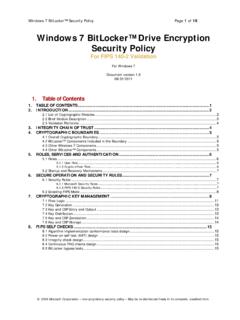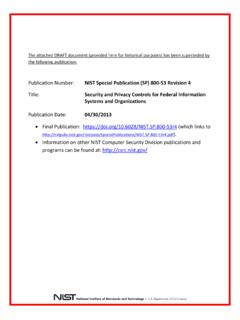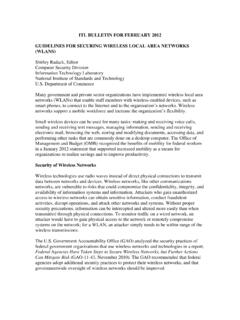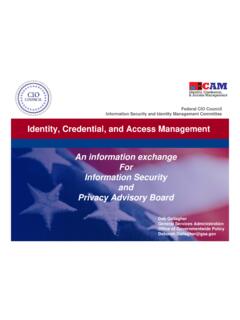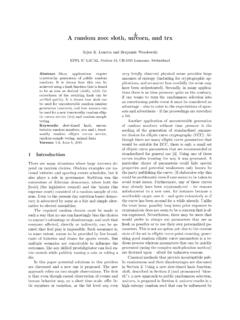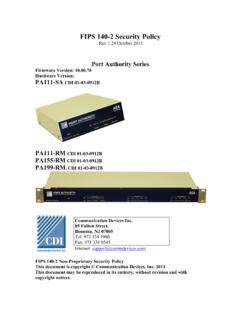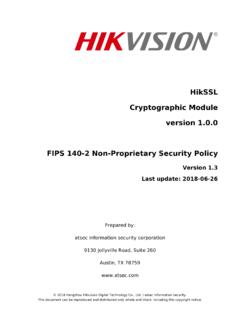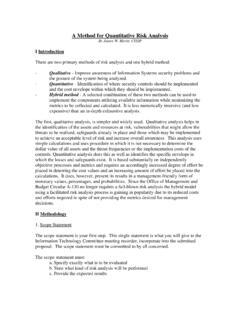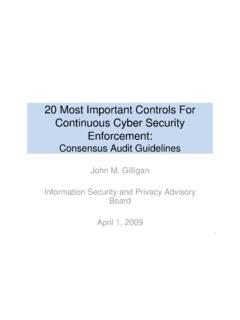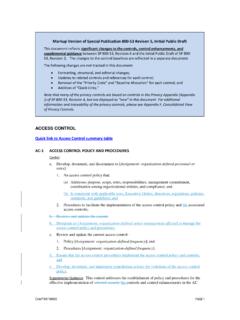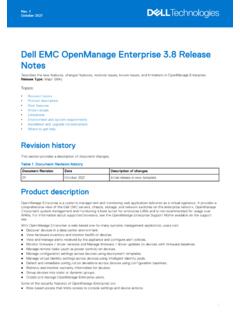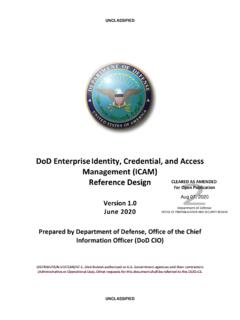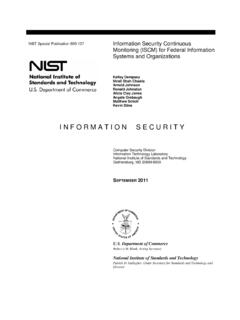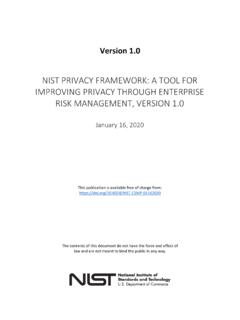Transcription of FAQs Continuous Monitoring, June 1, 2010
1 National Institute of Standards and Technology June 1, 2010 FREQUENTLY ASKED QUESTIONS Continuous monitoring 1. What is Continuous monitoring ?
2 Continuous monitoring is one of six steps in the Risk Management Framework (RMF) described in NIST Special Publication 800 37, Revision 1, Applying the Risk Management Framework to Federal Information Systems (February 2010). See Figure 1 below. The objective of a Continuous monitoring program is to determine if the complete set of planned, required, and deployed security controls within an information system or inherited by the system continue to be effective over time in light of the inevitable changes that occur. Continuous monitoring is an important activity in assessing the security impacts on an information system resulting from planned and unplanned changes to the hardware, software, firmware, or environment of operation (including threat space).
3 Authorizing Officials risk based decisions ( , security authorization decisions) should consider how Continuous monitoring will be implemented organization wide as one of the components of the security life cycle represented by the RMF. The Federal Information Security Management Act (FISMA) of 2002, OMB policy, and the implementing standards and guidelines developed by NIST require a Continuous monitoring approach. FIGURE 1. Starting Point RISK MANAGEMENT FRAMEWORK PROCESS OVERVIEW Architecture Description Architecture Reference Models Segment and Solution Architectures Mission and Business Processes Information system Boundaries Organizational Inputs Laws, Directives.
4 Policy Guidance Strategic Goals and Objectives Priorities and Resource Availability Supply Chain Considerations Repeat as necessary Step 6 MONITOR Security Controls Step 2 SELECT Security Controls Step 3 IMPLEMENT Security Controls Step 4 ASSESS Security Controls Step 5 AUTHORIZE Information system Step 1 CATEGORIZE Information system
5 National Institute of Standards and Technology June 1, 2010 2. If my information system is subject to Continuous monitoring , does that mean it does not have to undergo security authorization? No. Security authorization, established in OMB Circular A 130 and reinforced by the risk management concepts in FISMA, requires the explicit review and acceptance of risk by an authorizing official on an ongoing basis.
6 These risk based decisions are based on security control assessments and Continuous monitoring activities. Continuous monitoring does not replace the security authorization requirement for federal information systems. Rather, Continuous monitoring is implemented as part of a holistic,, risk management and (defense in depth) information security strategy that is integrated into enterprise architectures and system development life cycles. The Continuous monitoring program, developed and implemented by an organization as a component in the RMF security life cycle based approach, becomes a consideration in the risk based decisions ( , security authorization decisions) rendered by Authorizing Officials.
7 Continuous monitoring also supports the FISMA requirement for conducting assessments of security controls with a frequency depending on risk, but no less than annually. 3. Why is Continuous monitoring not replacing the traditional security authorization process? Continuous monitoring in and of itself, does not provide a comprehensive, enterprise wide risk management approach. Rather, it is a key component in the risk management process. NIST has been working with the Department of Defense, the Intelligence Community, and the Committee on National Security Systems to develop a unified information security framework for the federal government and its contractors.
8 The fundamental tenet of the unified information security framework is an enterprise wide risk management approach to information security that is life cycle based and implemented across three hierarchical tiers within an organization ( , governance, mission/business process, and information system ). The RMF, the central construct in NIST Special Publication 800 37, employs a security life cycle approach when considering information system security. The six step RMF fundamentally transformed the previous Certification and Accreditation (C&A) process to provide emphasis on front end and back end security. The ongoing determination and acceptance of information system security related risks remains the primary responsibility of Authorizing Officials and for which they are held accountable.
9 Continuous monitoring activities contribute to helping Authorizing Officials make better risk based decisions, but do not replace the security authorization process. 4. What is front end security and how does it differ from back end security? Front end security, exemplified by the first three steps in the RMF (security categorization, security control selection, and implementation), focuses on building security into information technology products and systems early in the system development life cycle. The initial steps are also linked to the organization s enterprise architecture and information security architecture. Better front end security results in fewer weaknesses and deficiencies in information systems, directly translating to a lesser number of vulnerabilities that can be exploited by threat sources.
10 Back end security, exemplified by the last three steps in the RMF (security control assessment, information system authorization, and Continuous monitoring ), focuses on the effectiveness of the implemented security controls, the determination and acceptance of risk, and the ongoing monitoring of the security state of the information system . The RMF overall provides a disciplined and structured process that integrates information security and risk management activities into the system development life cycle.
